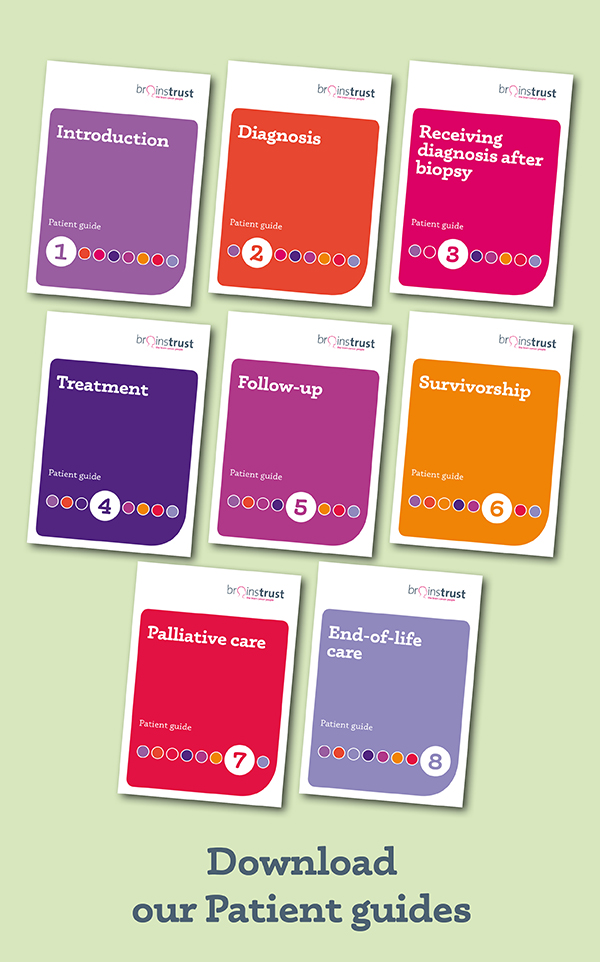Radiotherapy and chemotherapy for brain tumours
Chemotherapy
Chemotherapy is a treatment which uses drugs to treat cancer cells. It works on cancer cells in three ways:
- It kills cancer cells
- It alters the cells damaging potential
- It ‘tees up’ the cancer cells for treatment with further drugs (also called pro-drug therapy).
Chemotherapy will not be offered to everybody. Each case will be assessed individually by the healthcare team, who should also be the people you ask any questions you may have about this treatment.
Here are some suggested questions that you might find helpful to ask if your loved one is offered Chemotherapy:
- What chemotherapy is being offered?
- What will the side effects be, physical and emotional?
- When will they kick in?
- If chemotherapy is offered, can molecular testing be done to see how the tumour will respond to the treatment?
- How long will it take them to recover from the treatment?
Radiotherapy
Radiation therapy kills brain tumour cells with high-energy x-rays, gamma rays, or protons. It usually follows surgery. The radiation kills brain tumour cells that may remain in the area, following surgery. Sometimes, people who can’t have surgery have radiation therapy instead. It may also be given in combination with chemotherapy. Radiotherapy is used in 50% of all cancer patients.
Radiosurgery
Radiosurgery is a medical procedure used for brain tumour treatment, as well as treatment for other forms of cancer. It uses non-invasive, highly precise radiation beams, usually in one single session, to destroy painlessly or shrink tumours that could otherwise be inaccessible for open surgery.
It is also known as stereotactic radiosurgery (SRS) when used to target brain tumours.
You may also hear these being referred to as Gamma Knife and Cyberknife. These are the commercial names, like Hoover is for vacuum cleaners.
 What type of radiotherapy do you suggest?
What type of radiotherapy do you suggest?- What will the side effects be, physical and emotional? And when will they kick in?
- Should someone come with them to radiotherapy sessions?
- Will they lose their hair?
- How long will it take to recover from the treatment?
- Is stereotactic radiotherapy/radiosurgery suitable?
Our Radiotherapy resource may help to answer some questions you might have and go through Radiotherapy treatment in more detail.
Or if you would like a copy sent to you in the post email hello@brainstrust.org.uk
Proton Beam Therapy for brain tumours
For proton beam therapy, the source of radiation is protons rather than x-rays (photons)
This is a type of particle therapy which uses a beam of protons to irradiate the tumour. The proton beam is aimed at the tumour. The dose of radiation to normal tissue from a proton beam is less than the dose from an x-ray beam. All protons of a given energy have a certain range; no proton penetrates beyond that distance, so this treatment is appropriate in cases where there is a need for the radiation dose to fall off to zero after it hits the target
Proton beam therapy can’t treat all cancers. It is just another form of radiotherapy, and not all cancers can be treated with radiotherapy.
 Proton beam therapy is useful in the following situations:
Proton beam therapy is useful in the following situations:- Tumours that are near important parts of the body. For example, tumours near the eye, brain and spinal cord.
- Childhood cancers of the eye, brain and spinal cord. Proton beam therapy lessens the chance of harming healthy developing tissue. It isn’t an effective treatment for cancers that have spread (metastases).
We have developed our Guide to Proton Beam Therapy which has been designed to help you feel more informed about the treatment and know where further help and information may be available.












